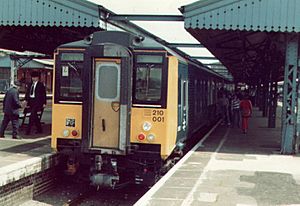British Rail Class 210 facts for kids
Quick facts for kids British Rail Class 210 |
|
|---|---|

Class 210 001 at Reading for a service to Didcot on 30 May 1982
|
|
| In service | 1981-c1987 |
| Manufacturer | BREL Derby |
| Number built | 2 |
| Formation | 4 cars (210 001) 3 cars (210 002) |
| Capacity | 203 (210 001) 254 (210 002) |
| Operator(s) | British Rail |
| Specifications | |
| Maximum speed | 90mph (145km/h) |
| Prime mover(s) | 1 x MTU 12V396 TC11 (210 001) 1 x Paxman 6RP200L (210 002) |
The British Rail Class 210 was a special type of train built in the early 1980s. It was a "diesel-electric multiple unit," which means it used diesel engines to make electricity, and that electricity powered the train's motors. These trains were designed to be a modern upgrade for older trains, especially in the southern parts of the British railway system. However, only two of these trains were ever built, and they didn't stay in service for very long.
Contents
What Was the British Rail Class 210?
The Class 210 was an experimental train. It was part of a plan to bring new, efficient trains to the UK. These trains were meant to be comfortable and fast. They were built by a company called BREL Derby.
Why Were These Trains Built?
In the 1970s, many trains in Britain were getting old. British Rail wanted to replace them with something new. They needed trains that could run on lines without overhead electric wires. The Class 210 was designed to be that new train. It was hoped it would be a modern solution for busy routes.
What Made Them Special?
The Class 210 trains were quite advanced for their time. They were built using parts similar to the successful Mark 3 coaches. This meant they were strong and comfortable.
- Power: Each train had a powerful diesel engine. One train used an MTU engine, and the other used a Paxman engine. These engines generated electricity to power the train.
- Speed: They could reach speeds of up to 90 miles per hour (145 km/h). This was quite fast for a diesel train.
- Capacity: One train could carry 203 passengers, and the other could carry 254. They were designed to move many people.
- Design: They looked sleek and modern. They were built with passenger comfort in mind.
Why Didn't They Go Into Full Production?
Even though the Class 210 trains were modern, they faced some challenges. Only two prototype trains were ever built. They were tested on various routes, including services from London Paddington to Reading and Oxford.
However, British Rail decided not to build more of them. One big reason was the cost. Building these advanced trains was expensive. Also, British Rail was starting to focus more on electrifying railway lines. Electric trains are often cheaper to run and more environmentally friendly. Because of these reasons, the Class 210 project was stopped.
Where Are They Now?
The two Class 210 prototype trains were withdrawn from service around 1987. They didn't have a long life on the tracks. Their parts were later used for other projects. For example, some of their parts helped build the Class 150 "Sprinter" trains. So, while the Class 210 itself didn't succeed, its technology helped develop future trains.

